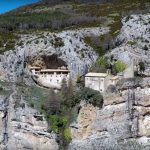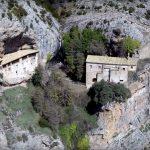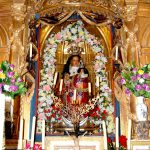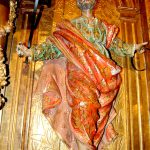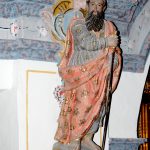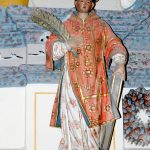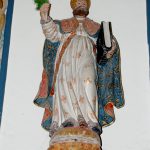Opening times
from 11:00 to 17:30from 11:00 to 17:30
Hermitage
Virgen de la Peña
(Aniés)


Welcome traveller, you have made an arduous journey to reach my door.
Now, while you catch your breath and calmly watch me, you should be aware that you are standing before one thousand years of history...
Come in, enter and listen to the voices within my stone walls.
You will take something of myself with you, something of you will remain with me...
Hermitage of Nuestra SeñoraVirgen de la Peña
ANIÉS

Welcome, come in, the door is open.
Before the guide arrives to talk to you about the Sanctuary and its surroundings, we will briefly summarise what we are going to discover behind these introspective walls.
Created by man and born out of legend, this Sanctuary will leave no-one indifferent… whether its own people, who live nearby but are unaware of its roots of stone, or strangers who have never heard anyone mention it.
Rest inside in silence, observe the living art that surrounds us and speaks to us with silent expressions, listen to the murmur of past pilgrims… feel the gaze of the images on their pedestals and tell them something about the path that you are on.
Enjoy the mystery of time passing through the centuries and, right now, feel a part of this moment and become a part of its history.
Welcome...


In Aniés, the village that forms part of La Sotonera and is situated between Bolea and Loarre, we find the setting for this hermitage, a product of the devotion of its inhabitants towards our Lady the Virgen de La Peña. In his contrasting writings and accounts, the Carmelite monk, Padre Faci, writes: "Aragon, kingdom of Christ, dowry of Mary Most Holy, founded on the motionless column of Our Lady in her city of Zaragoza", he makes a brief allusion as to the origins of the hermitage, as well as to its location and its mysteries. Below, is a reproduction of the original fragment, without changes or corrections, of the visit made by to our Sanctuary by Padre Faci.
It is situated in Aniés between the old and noble villages of Ayerbe and Boleain the foothills of the Jaca mountains. The holy image of Our Lady of Peña (of the rock) is worshipped in that village, known by that name because its sanctuary is built on a rock. Looking at its height and its steepness before you attemp to climb, it seems impossible to climb such a steep hill. And when you try, it is always difficult and naturally dangerous, because there is, and will never be, any other way up than the one created more by devotion than art, forming gradients that encircle the bare rock and pathways as narrow as they are dangerous. Only on some of them can you find a sure footing, causing the natural and ever-present fear falling. For this reason, it is inaccessible for any type of cavalry. The distance from the village of Aniés to the base of the rock is about three quarters of an hour, and the ascent I refer to, is more than another long quarter league. And after climbing up in the way described, and having either overcome or won the climb, you become aware of another strange event. Well, to reach the church, you have to go down at least forty two or more stone steps by which you enter a concave or hollow space in which a small square can be seen.
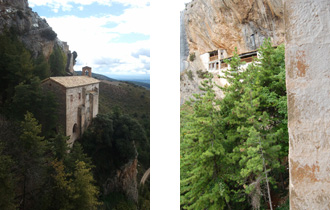
According to the traditions of those mountains, the discovery of the Holy Image in that site of pilgrimage occurred in this way.

There was a cavalry soldier who was garrisoned in Castle Loarre and who had gone hunting in those mountains with his falcon [...]
[...] he let it go against a distant partridge which, fleeing from its cruel enemy flew into the hollow mentioned, and into which, following the partridge, the falcon flew. It was in there for such a long time without returning to its master's hand that, fearing he had lost it, the soldier began to attempt to recover it. He attempted to descend to the hollow, but at that time it was impossible (without the stone steps that are there today), so he sent a servant who he tied to a long rope. The servant reached the depths and found an altarpiece there depicting a thick bush and, to the right of it, there was an image of the Virgin. In the darkness, the partridge was still alive, leaning against the falcon and free of its cruelty, almost as if he had forgotten his bloodthirsty instinct. He appeared to be suspended and astonished at how, in such a hidden place, there could be such a beautiful sight. The soldier returned home, happier with the news of the treasure, and told the Christians of his unusual news. They went to the place in procession and removed the Holy Image from there and moved it to the ancient church of Saint Paul the Apostle which at that time was situated at the foot of the rock. Today there are only traces of the old church and of some other neighbouring walls that the people of Aniés believe to have been Templars.

The legend says that from the church of Saint Paul, the Holy Image was once, or more times, taken back to the hollow in the rock where it had been found by the servant and the soldier. This was done by the inhabiants of Aniés, and following the wishes of Our Lady, they erected the church in that hollow where she is worshipped today. From a written memory which is presenrved in that church, it can be inferred that this apparition took place around 903.
The image is made of wood and its face and clothing are exquisitely sculpted. It stands four hands high. Our Lady is standing and holds the Jesus Child in her left arm. In her right hand there is a red apple. The Jesus Child holds a yellow apple in his left hand and his right hand is lifted in a gesture, as if he is blessing the people.
Here are some accounts of miracles.

The villages of Aniés, Rasal and Ventué gathered together to worship the Holy Image on the 9th of May 1717. At first, the church was full of worshippers hearing the mass, which was sung and, all of a sudden a quarter of the church that was joined to other Sanctuary buildings fell or sank and 25 people who were close by fell in. The drop was deep, about 24 hands in height, and three floors sank into it. Despite this terrible ruin, none of the 25 who fell was harmed or had any injury. Only one man had a light scratch on his nose due to trying to get out of the ruins too quickly.
There are many respected contributions that relate deeds to this Holy Image. Among these, three stand out. A Baroness of Ayerbe, (whose name is not known), finding that she was infertile came to this Sovereign Lady. Through her blessing she produced an heir, and as a gesture of her appreciation she corresponded with a gift of four well-crafted silver objects which were two candelabra and two candlesticks.

A gentleman from Nisano (from the very noble Urries family from Huesca), found himself imprisoned and accused of a serious crime which endangered his honour and his life. From his cell, he beseeched the favour of this Holy Image and, through her intercession he regained his freedom and honour, which he acknowledged with the donation of a silver lamp. A gypsy woman offered this Sovereign Lady a gold chain. The devotion of this gypsy woman exceeded the devotion of many ladies and gentlemen whose gratitude came without the need to overcome some adversity. She had climbed to the Sanctuary in the company of this group of wanderers as a pilgrim. She was carrying her small daughter who was misbehaving, as they do at that age, near the cliff of the rock. She fell and rolled the full height of the rock right down to the the plain below where the climb begins. Having witnessed this tragedy, they descended the path to find her in order to bury her, believing that not only she had died but that would also be torn to pieces. The mother was inconsolable and she prostrated herself at the feet of Our Lady asking for the safe return of her child. The answer to this prayer was that the child was found safe and calm and playing with some stones at the foot of that rock. The mother was so grateful for such an undescribable favour that, with the generosity of a pilgrim and as though she were a noblewoman, she offered and later gave Our Lady a rich and heavy chain of the finest gold, and the Virgin wears this on her feast days.

For its worship and care, this Sanctuary has a hermit that collects many donations offered by the faithful. He lives there for as much time as is allowed by the inclement snow and ice. There is also a very clean room where devotees can find shelter from the high and isolated mountains.
P. Alberto Faci
Opening times and prices
From Holy Thursday to 12 October
days 6, 7, 8 and 9
of April
from 11:00 to 13:30
price
per person
2,50 €
- Guided tours of the Sanctuary.
- Possibility of taking small groups to the summit with an adapted 4x4 vehicle.
- Visits can be made by appointment outside the established opening hours.

Information and reservations:
974 342 161 • 690 636 080 • 649 307 480informacionyreservas@castillodeloarre.es
